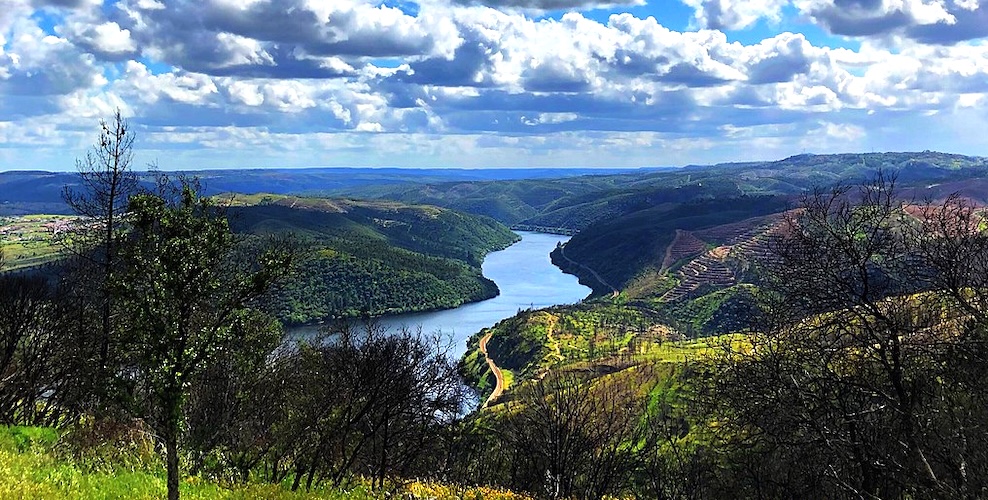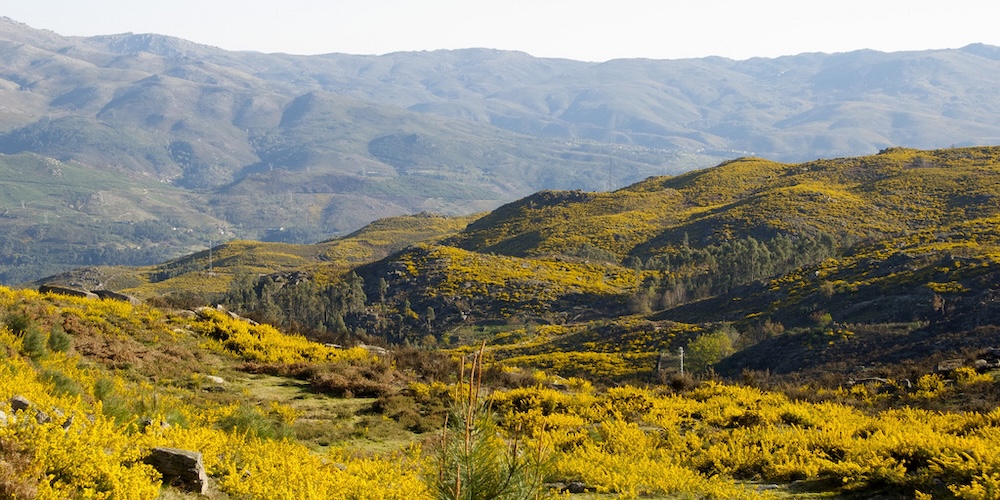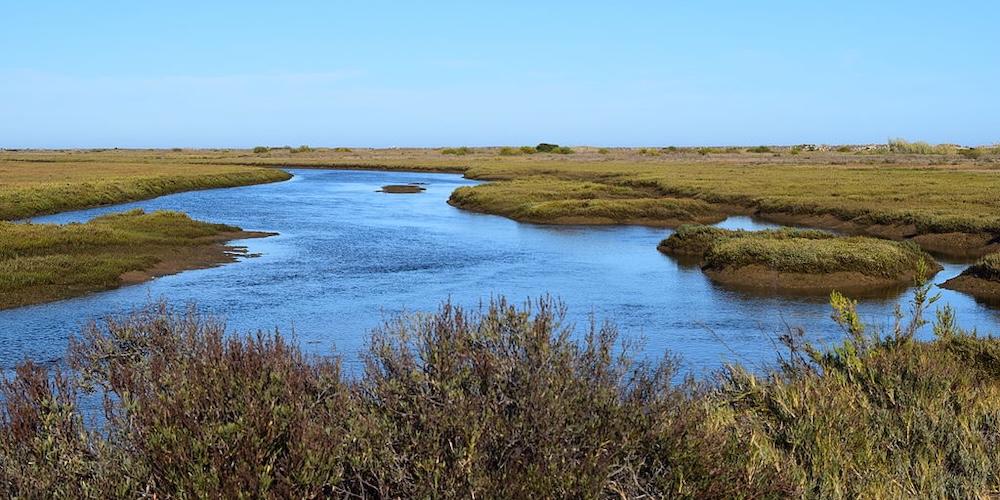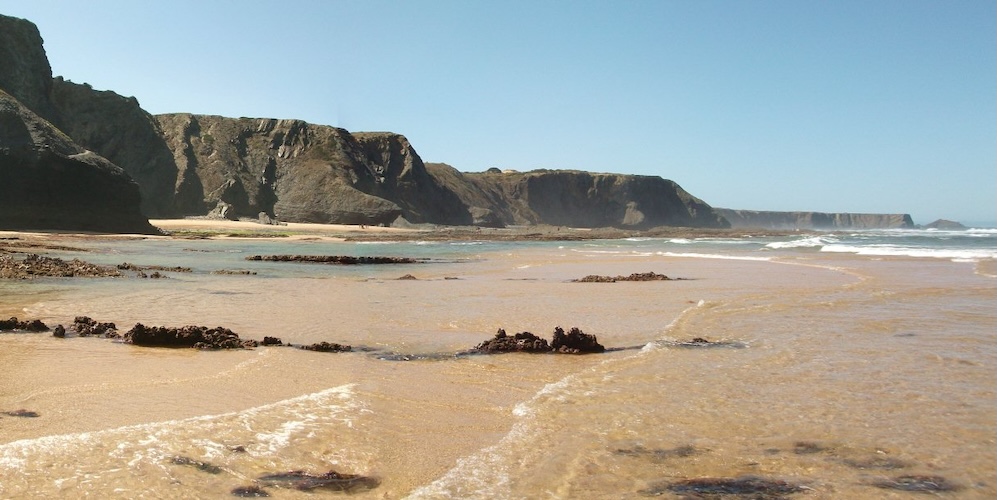Portuguese Republic

Portugal is a country in the Iberian Peninsula in Southwestern Europe with a population of around 10.5 million people. Featuring the westernmost point in continental Europe, Portugal borders Spain to its north and east, with which it shares the longest uninterrupted border in the European Union; to the south and the west is the North Atlantic Ocean; and to the west and southwest lie the Macaronesian archipelagos of the Azores and Madeira, which are the two autonomous regions of Portugal. Lisbon is the capital and largest city with three million inhabitants, followed by Porto with 1.3 million, which is the only other metropolitan area.
Continental Portugal is split by its main river, the Tagus, that flows from Spain and disgorges in the Tagus Estuary at Lisbon, into the Atlantic. The northern landscape is mountainous towards the interior with several plateaus indented by river valleys, whereas the south, including the Algarve and the Alentejo regions, is characterized by rolling plains.

Tagus River Valley – ©Sempreconvosco CC BY-SA 4.0 via Wikimedia Commons
Portugal’s highest peak is Mount Pico on Pico Island in the Azores. The archipelagos of Madeira and the Azores are scattered within the Atlantic Ocean: the Azores straddling the Mid-Atlantic Ridge on a tectonic triple junction, and Madeira along a range formed by in-plate hotspot geology. Geologically, these islands were formed by volcanic and seismic events.
Portugal is mainly characterised by a Mediterranean climate, temperate maritime climate in high altitude zones of the Azorean islands; a semi-arid climate in parts of the Beja District far south and in Porto Santo Island, a hot desert climate in the Selvagens Islands and a humid subtropical climate in the western Azores. It is one of the warmest countries in Europe: the average temperature in mainland Portugal varies from 10–12 ° in the mountainous interior north to 17–19 °C in the south and on the Guadiana river basin. There are variations from the highlands to the lowlands. The Algarve, separated from the Alentejo region by mountains reaching up to 3,000 feet in Alto da Fóia, has a climate similar to that of the southern coastal areas of Spain or Southwest Australia.

Peneda-Gerês National Park – ©manjerix CC BY-SA 2.0 via Wikimedia Commons
Annual average rainfall in the mainland varies from just over 126 inches on the Peneda-Gerês National Park to less than 20 inches in southern parts of Alentejo. Mount Pico receives the largest annual rainfall over 246 inches per year. In some areas, such as the Guadiana basin, annual diurnal average temperatures can be as high as 24.5 °C and summer’s highest temperatures are routinely over 40 °C. Snowfalls occur regularly, in the winter, in the interior North and Centre, particularly on the mountains. In winter, temperatures may drop below −10.0 °C. In these places snow can fall any time from October to May. In the South snowfalls are rare but still occur in the highest elevations. While the official absolute minimum is −16.0 °C in Penhas da Saúde and Miranda do Douro, lower temperatures have been recorded. Continental Portugal receives around 2,300-3,200 hours of sunshine annually, an average of 4–6 hours in winter and 10–12 hours in the summer, with higher values in the south-east, south-west, Algarve coast and lower in the north-west. Portugal’s central west and southwest coasts have an extreme ocean seasonal lag; sea temperatures are warmer in October than in July and are their coldest in March. The average sea surface temperature on the west coast of mainland Portugal varies from 14–16 °C in January−March to 19–21 °C in August−October while on the south coast it ranges from 16 °C in January−March and rises in the summer to about 22–23 °C, occasionally reaching higher. In the Azores, around 16 °C in February−April to 22–24 °C in July−September, and in Madeira, around 18 °C in February−April to 23–24 °C in August−October.

Ria Formosa Natural Park – ©Ricardo Oliveira CC BY-SA 3.0 via Wikimedia Commons
Azores and Madeira have a subtropical climate, although variations between islands exist. The Madeira and Azorean archipelagos have a narrower temperature range, with annual average temperatures exceeding 20 °C in some parts of the coast. Some islands in the Azores have drier months in the summer. Consequently, the islands of the Azores have been identified as having a Mediterranean climate, while some islands (such as Flores or Corvo) are classified as Humid subtropical, transitioning into an Oceanic climate at higher altitudes. Porto Santo Island in Madeira has a warm semi-arid climate. The Savage Islands, which are part of the regional territory of Madeira and a nature reserve are unique in being classified as a desert climate with an annual average rainfall of approximately under 6 inches.
Birding Portugal
Portugal is located on the Mediterranean Basin, the third most diverse hotspot of flora in the world. It is home to six terrestrial ecoregions: Azores temperate mixed forests, Cantabrian mixed forests, Madeira evergreen forests, Iberian sclerophyllous and semi-deciduous forests, Northwest Iberian montane forests, and Southwest Iberian Mediterranean sclerophyllous and mixed forests. Over 22% of its land area is included in the Natura 2000 network. Eucalyptus, cork oak and maritime pine together make up 71% of the total forested area of continental Portugal. Geographical and climatic conditions facilitate the introduction of exotic species that later turn to be invasive and destructive to the native habitats. Around 20 percent of the total number of extant species in continental Portugal are exotic. Portugal has the second highest number of threatened animal and plant species in Europe.
The large mammalian species of Portugal (deer, Iberian ibex, wild boar, red fox, Iberian wolf and Iberian lynx) were once widespread throughout the country, but intense hunting, habitat degradation and growing pressure from agriculture and livestock reduced population on a large scale in the 19th and early 20th century, others, such as the Portuguese ibex were even led to extinction. Today, these animals are re-expanding their ranges. Some protected areas of Portugal include: the Serras de Aire e Candeeiros, the Southwest Alentejo and Vicentine Coast Natural Park and the Montesinho Natural Park which hosts some of the last populations of Iberian wolf and Iberian brown bear.

Montesinho Natural Park – ©Miguel Vieira CC BY 2.0 via Wikimedia Commons
Portugal is a great country for birdwatchers – both residents and visitors. This small country has been largely ignored by ornithologists who target Spain, yet it has a lot to offer, not only in terms of breeding birds, but also in migrants and non-breeding visitors – seabirds form an important part of what is on offer, both on the mainland and on the archipelagos of Madeira and the Azores. The number of people taking an interest in nature and birds is still relatively low, at least when compared with many other European countries, yet the number of ornithologists and birders has undergone a clear increase in recent years, giving Portuguese organisations some encouragement to proceed with their work in this important area.
Visiting birdwatchers are encouraged to get in touch with national associations, in order to get updated information about where to go and also to give some feed-back about their experiences in this country. Portugal as a whole is an important stopover for migratory bird species. Apart from the birds, Portugal is also interesting from other points of view – landscape, vegetation, history, monuments, beaches, gastronomy… It is almost guaranteed that a visit to Portugal will be interesting from many points of view.

Vicentine Coast Natural Park – ©Paula F Souza CC BY-SA 4.0 via Wikimedia Commons
Overshadowed by its larger neighbour many birders are completely unaware of that many of the most sought-after species in Spain are also found in Portugal such as Great Bustard, Azure-winged Magpie, Great-spotted Cuckoo, Booted eagle etc. as well as many warblers, shrikes, waders and passerines.

-
Number of bird species: 632
(As at April 2025) Includes Madeira & Azores -
Number of bird species: 490
Mainland Portugal
Number of endemics: 3
Madeira Laurel Pigeon Columba trocaz
Azores Bullfinch Pyrrhula murina
Madeira Firecrest Regulus madeirensis
-
Avibase
PDF ChecklistThis checklist includes all bird species found in Portugal , based on the best information available at this time. It is based on a wide variety of sources that I collated over many years. I am pleased to offer these checklists as a service to birdwatchers. If you find any error, please do not hesitate to report them. -
Avibase (Mainland)
PDF ChecklistThis checklist includes all bird species found in Portugal (continental) , based on the best information available at this time. It is based on a wide variety of sources that I collated over many years. I am pleased to offer these checklists as a service to birdwatchers. If you find any error, please do not hesitate to report them. -
E-Bird (Mainland)
PDF ChecklistThis checklist is generated with data from eBird (ebird.org), a global database of bird sightings from birders like you. If you enjoy this checklist, please consider contributing your sightings to eBird. It is 100% free to take part, and your observations will help support birders, researchers, and conservationists worldwide. -
Wikipedia
Annotated ListThis is a list of the bird species recorded in Portugal. The avifauna of mainland Portugal, the Azores, and Madeira islands included a total of 632 species as of October 2024 according to Avibase. Of them, 16 have been introduced by humans. 3 are endemic to islands, one is extinct.
-
A Birdwatchers' Guide to Portugal, the Azores & Madeira Archipelagos
| By Colm Moore, Goncalo Elias & Helder Costa | Prion | 2014 (Second Edition) | Paperback | 212 pages, b/w illustrations, b/w maps | Out of Print | ISBN: 9781871104134 Buy this book from NHBS.com -
Aves de Portugal (Birds of Portugal)
| By Helder Costa, Eduardo de Juana Aranzana & Juan M Varela Simó | Lynx Edicions | 2028 | 2nd Edition | Hardback | 260 pages, plates with 800+ colour illustrations; 253 colour distribution maps | ISBN: 9788416728114 Buy this book from NHBS.com -
Birds of Europe, North Africa, and the Middle East
| Photographic Guide | By Frédéric Jiguet & Aurélien Audevard | PUP | 2017 | Paperback | 447 pages, 2200 colour photos, colour distribution maps | ISBN: 9780691172439 Buy this book from NHBS.com -
Birds of Portugal: An Annotated Checklist
| By Gonçalo Elias | Gonçalo Elias | 2022 | Third Edition) | Paperback | 159 pages, B&W Illustrations || ISBN: 9798417140600 Buy this book from NHBS.com -
Collins Bird Guide
| By Lars Svensson | Harper Collins | Edition 3 | 2023 | Paperback | 478 pages, 4000+ colour illustrations, 700 colour distribution maps | ISBN: 9780008547462 Buy this book from NHBS.com -
Finding Birds in South Portugal - Booklet
| By Dave Gosney | Easy Birder | 2013 | Paperback | 40 pages, b/w maps | ISBN: 9781907316401 Buy this book from NHBS.com -
Finding Birds in South Portugal - DVD
| By Dave Gosney | Easybirder | 2013 | DVD | Runtime: 78 min | ISBN: 9781907316418 Buy this book from NHBS.com -
The Birds of the Iberian Peninsula
| By Eduardo de Juana & Ernest Garcia | Bloomsbury | 2015 | Hardback| 688 Pages | 32 plates with 64 colour photos | 216 b/w illustrations | b/w distribution map | ISBN: 9781408124802 Buy this book from NHBS.com -
Where to Watch Birds in Portugal, the Azores & Madeira Archipelagos
| By Colm Moore, Gonçalo Elias & Helder Costa | Pelagic Publishing | 2020 | Edition 2 | Paperback | 212 pages, b/w illustrations, b/w maps | ISBN: 9781784272234 Buy this book from NHBS.com

Collins Bird Guide
AndroidThe Collins Bird Guide App provides everything you need to identify a species quickly and learn about it thoroughly.
Collins Bird Guide
Apple iOS |Collins Bird Guide 4+ A field guide to Europe NatureGuides Ltd. Designed for iPadOrganisations-
Associacao Cientifica para o Conservacao das Aves de Rapina
WebsiteLuis Filipe Oliveira, Apt 105, P-2775 Carcavelos. +351 14530204. -
Sociedade Portguesa para o Estudo das Aves
WebsiteSPEA, Rua da Vitoria, 53 - 3-Esq, 1100- 618 Lisboa. +351 21 3220430 spea@spea.pt S.P.E.A. is the Portuguese Society for the Study of Birds, and is a scientific organization that works for the development of ornithology in this country and for the conservation of birds and their habitats. S.P.E.A. congregates most Portuguese ornithologists and birdwatchers, as well as people that care for the birds and their preservation in a healthy environment. S.P.E.A. is the Portuguese Partner (Designate) of BirdLife International, an organization with worldwide implantation with partners in more than 60 countries.
Reserves-
*Protected areas of Portugal
InformationSatellite ViewMap of areas with interactive links to parks, resewrves etc -
NP Parque Natural da Ria Formosa
WebpageSatellite ViewFauna: flamingo, gray plover, curlew, several ducks (royal, "trumpeter", shoveller, duckling), halcyon, sand hawthorn berry, sea turtle-dove, dwarf long billed tern, sea-swallow with red beak, small white heron, sultana-chicken (porphyrio porphyrio), rock-bass, gilthead, sargus, around 3 hundred of shell-fishes, several crustaceos (shrimps, spider crab, ...), chameleon, turkish house lizard, viperine water snake, genet, badger, weasel, fox, otter, shrewmole, mole, hedgehog. -
NP Parque Natural de Montesinho
WebpageSatellite ViewFauna: wolf, deer, roe deer, boar, otter, mole, royal eagle, black sweep, hunter and blue kestrel, grey partridge, screech-owl (coruja-das-torres). -
NP Parque Natural do Sudoeste Alentejano e Costa Vicentina
WebpageSatellite ViewFauna: The birds are the main fauna of the park, around 2 hundred species. The several species one can found are: "fishery" eagle (pandion haliaetus), kite with flat back, Bonneli eagle ( hieraaetus fasatus), white stork, the "towers'" kite, the hawk "peregrino", "the rocks'" pigeon, fox, genet, wild cat, weasel, Iberian lynx, otter, Iberian brushwood sand-lizard, salamander with yellow spots, tree-frog. -
NP Peneda-Gerês National Park
InformationSatellite ViewIt covers an area of 695.9 km2 (268.7 sq mi), occupying the Districts of Viana do Castelo, Braga, and Vila Real and bordering the Spanish Baixa Limia – Serra do Xurés natural park to the north, with which forms the UNESCO biosphere reserve of Gerês-Xurés -
Natural Parks
WebsiteSatellite ViewBasic Information on all of Portugal`s national and regional parks including flora and fauna likely to be encountered.
Guides & Tour Operators-
Alentejo Birdwatching
Local Tour OperatorAlentejo Birdwatching offers individual birding holidays but also guided bird tours and excursions as well as accommodation in the Alentejo region of Portugal -
Algarve Birdwatching
Local Tour OperatorAdditionally, the nature rich Sagres peninsular and the fabulous steppic habitats of the Baixo Alentejo are within easy reach and present some of the most rewarding birding in the Iberian Peninsula. Bringing you in close contact with all the birdlife of this region, as well as its unique habitats and other wildlife. Using personally acquired and detailed local knowledge these guided tours focus on revealing the more difficult species apart from the well known. European Bee-eater Merops apiaster is a common bird here and found almost everwhere throughout southern Portugal . -
Birding Ecotours
Tour OperatorOur Portugal birding tours are a bit more relaxed than our typical birding tours and also enjoy some of the country’s finest vineyards and cultural highlights. -
Birding in Portugal
Local Tour OperatorBirding-in-portugal.com blends guided birdwatching throughout southern Portugal with a centralised location in a sparsely populated region of unique beauty. It's aim is to let you see the birds and countryside you wish to see and as much of them and it as possible, directing or taking you to places normally unfrequented by tourists. With its wealth of experience and flexibility of outlook it aims to satisfy any visitor to this wonderful region, whether they wish to have a guide or simply to birdwatch on their own -
Birds & Nature Tours
Local Tour OperatorBirds & Nature Tours is the first and only Portuguese company specifically dedicated to birds and birding field tours. We offer you a wide variety of programmes, including guided field tours and bird-dedicated courses -
FieldGuides
Tour OperatorA Birds & Wine Tour - A new itinerary in our popular Birds & Wine tour series. -
HeatherLea
Tour OperatorPortugal has a warm climate, superb scenery and an impressive diversity of breeding birds, including a number of species with restricted range in Europe. -
Iberian Wildlife Tours
Tour OperatorWe are all British, freelance, natural history tour leaders who have been living in our respective regions of Spain for many years. Our experience of leading wildlife holidays in Spain and Portugal dates from 1989, both with established wildlife tour companies and a tailor-made basis for independent groups -
Naturalist Journeys
Tour OperatorNaturalist Journeys is excited to offer Portugal birding tours with expert local operators and experienced Naturalist Journeys guides. -
NatureTrek
Tour OperatorA relaxing 7-day holiday to enjoy the autumn bird migration, beautiful scenery and pleasant climate of southern Portugal. -
Rockjumper
Tour OperatorPortugal - Birds and Wine in Winter -
Sabrewing
Tour OperatorThis is a birding tour, designed to see as many bird species as possible, with special focus on specialty species. -
Salva Fauna
Local Tour OperatorBirding Day Trip in Algarve -
The Travelling Naturalist
Tour OperatorWith its great diversity of habitat providing first landfall for thousands of spring migrants, good feeding grounds for birds on autumn migration, and a fine range of resident birds on the coast and inland -
Visit Portugal Birdwatching
Local Tour OperatorWe offer private-guide services for individuals, groups, clubs and associations, both in the area of birding and in the area of bird photography. These private tours can range from just a day away from the city (half and full day tours) to birding or bird photography holidays (Short-break, Week-long or more and Tailor-made itineraries) at any time of the year. Besides private tours, we organize standard pre-scheduled tours in Portugal, for which you can make a reservation directly (min. 4, max. 7 participants). -
WINGS
Tour OperatorPortugal Birds and Culture
Trip Reports-
2019 [03 March] - Ella Maria and Leif Bisschop-Larsen - Southern Portugal
PDF ReportOur aim was to enjoy nature and bird-life of the region Alentejo in a relaxing way. This short report contains notes on our tour with a list of species. Because it was early in the season, we did not expect to see that many species of birds, but we were quite happy with the outcome anyway. -
2019 [06 June] - David Bradnum - Seville & Alentejo
PDF ReportThis was a short, low-cost birding break to Spain and Portugal. We had two aims: to see a handful of late-arriving spring migrants – White-rumped Swift, Western Olivaceous Warbler and Rufous-tailed Scrub-robin – and to enjoy as many as possible of the local specialities on the Castro Verde plains and the Rio Guadiana valley. -
2022 [10 October] - Gerard Gorman
PDF Report...We observed a varied assortment of fabulous bird species – eagles, vultures, owls, shorebirds, wildfowl, songbirds, seabirds, and the Eurasian Hoopoe and the colorful Kingfisher, two favorites. Other wonderful wildlife experienced included pods of Common Dolphins by right by our boat, close views of Fallow Deer and a curious Wild Boar and Eurasian Otter active in broad daylight... -
2023 [04 April] - Ann Gifford
PDF Report...Despite our very best efforts, the only birds we saw were a Blue rock thrush singing its little heart out for at least an hour way up a control tower, Corn bunting, Goldfinch, Red-rumped swallow, Wren, Stonechat, Blackbird and a Northern wheatear seen by Roland... -
2023 [10 October] - s João Tiago Tavares & Gerard Gorman
PDF ReportAnnotated List -
2024 [03 March] - Bob Swann
PDF Report...n. In the reedy channel closest to the cycle track a Little Bittern and lots of displaying Black-headed Weaver. Overhead good numbers Barn Swallow, House Martin and a Sand Martin... -
2024 [04 April] - Pat Lueders
PDF ReportVOTED FAVORITE BIRDS OF THE TRIP: 1.) WOODCHAT SHRIKE 2.) HOOPOE 3.) BLACK-HEADED WEAVER -
2024 [05 May] - Gordon Shaw
PDF ReportThe Western part of the island is a good site, the last km or so to the end has good habitat for all the passerines on the Southern (seaward) side and there seems to be an EU project in progress to protect it. As with most EU projects, it seems a good percentage of the budget is spent on signs telling you what they are doing, and who is doing it. -
2024 [06 June] - Erik Kleyheeg
PDF ReportSouthern Portugal Annotated bird list -
2024 [08 August] - António Cotão
PDF ReportDuring the first three days we birded around the Tagus River estuary, enjoyed delicious meals, and visited a local winery.
Places to Stay-
Quinta do Barranco da Estrada (Gully Road Farm)
AccommodationA small, 7 bedroomed south facing lakeside hotel with stunning views over one of Europe`s largest and cleanest lakes, it is set in unspoilt countryside one and a half hours from Faro International Airport. The cooking is to a cordon bleu standard, and the friendliness and professionalism of the international staff make a holiday here something to be treasured. The lake, though close to the Algarve, is relatively unknown, with a busy day being the sight of over five boats, and in the summer the mature fruit and flower gardens lead guests down to the shore where a variety of watersports are on offer, overlooked by the lawns close to the water`s edge.
Other Links
Fatbirder - linking birders worldwide...
Skip to content
